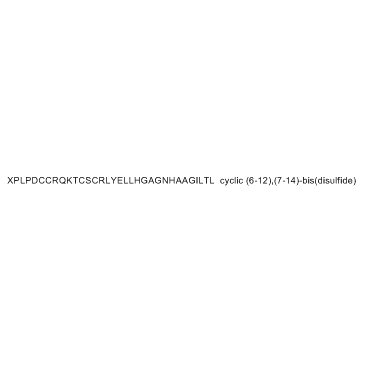205640-90-0
| Name | Orexin A (human, rat, mouse) |
|---|---|
| Synonyms |
M.W. 3561.12 C152H243N47O44S4
Hypocretin 1 OREXINS OREXIN A HUMAN,RAT,MOUSE Oroxin A OREXIN A,BOVINE,HUMAN,MOUSE,RAT Baicalin-7-glucoside HYPOCRETIN OREXIN A PYR-PRO-LEU-PRO-ASP-CYS-CYS-ARG-GLN-LYS-THR-CYS-SER-CYS-ARG-LEU-TYR-GLU-LEU-LEU-HIS-GLY-ALA-GLY-ASN-HIS-ALA-ALA-GLY-ILE-LEU-THR-LEU-NH2(DISULFIDE BRIDGE: CYS6-CYS12,CYS7-CYS14) Pyr-PLPDCCRQKTCSCRLYELLHGAGNHAAGILTL-NH2(Disulfidebridge:6-12and7-14) Rat orexin A |
| Description | Rat orexin A is an important neuropeptide involved in the regulation of feeding, arousal, energy consuming, and reward seeking in the body. |
|---|---|
| Related Catalog | |
| In Vitro | Rat orexin A is an important neuropeptide involved in the regulation of feeding, arousal, energy consuming, and reward seeking in the body. It is found that Rat orexin A promotes astrocytes migration in different time and concentrations. Rat orexin A has a maximal effect at 10 nM and 24 h treatment (increases the migrating distance of the astrocytes into ~240%, increases the migrating area of the astrocytes into ~190%). Results also demonstrate that Rat orexin A-induced phosphorylation of ERK1/2 is significantly elevated (0.38±0.03 in Rat orexin A 10 nM group vs. 0.21±0.01 in control group, n=3, p<0.05) in primary cortical astrocytes. |
| In Vivo | Rat orexin A delays the day of vaginal opening in rats of Group 4 comparing to that in Group 3. Results indicate that injection of Rat orexin A can ameliorate central precocious puberty in rats. Lower mRNA level of MEG3 is observed in precocious puberty rats injected with Rat orexin A than that in precocious puberty rats injected with normal saline. Rat orexin A also reverses the dysregulation of Kisspeptin in hypothalamus of central precocious puberty rats[2]. In A6, many or most dopamine β hydroxylase (DBH)-positive neurons appear to be activated by Rat orexin A. Results also demonstrate that food intake is significantly enhanced by local Rat orexin A injection (P<0.05; n=9)[3]. |
| Cell Assay | Astrocyte cells are grown to confluence in dishes and starved with serum-free DMED/F12 medium for 24 h. The monolayer cells are manually scratched in the center of the dishes with a bright and clear field. The detached cells are removed by washing the cells once with PBS. Serum-free DMEM/F12 medium with or without Rat orexin A is added to each dish as indicated after pretreatment with the inhibitor for 30 min. Then the cells are separately fixed with 4% paraformaldehyde and labeled with anti-GFAP (1:200) for photography and analyzing of the cell migration at 0, 24 and 48 h. Images of migratory cells from the scratched boundary are observed and acquired at different time with a digital camera and a light microscope[1]. |
| Animal Admin | Five-days-old specific pathogen free grade female SD rats, weighing (25±5) g are used in this study. After two days of adaptive feeding, rats are randomly divided into four groups: Group 1 (normal control, n=12), Group 2 (precocious puberty rats, n=12), Group 3 (precocious puberty rats treated with normal saline, n=12), Group 4 (precocious puberty rats treated with Rat orexin A, n=12). Each rat in experimental groups 2, 3 and 4 are subcutaneously injected with 300 μg of danazol to establish the precocious puberty model. Each rat in groups 4 is injected with Rat orexin A (0.5 nM) for 1 time/day via lateral ventricle at 15-days-old. Each rat in groups 3 is injected with equal volumes of normal saline. When rats are 20-days-old, vaginal openings are checked and vaginal opening time (VO) is recorded[2]. |
| References |
| Molecular Formula | C152H243N47O44S4 |
|---|---|
| Molecular Weight | 3561.10 |
| PSA | 1589.89000 |
| LogP | 1.15650 |

